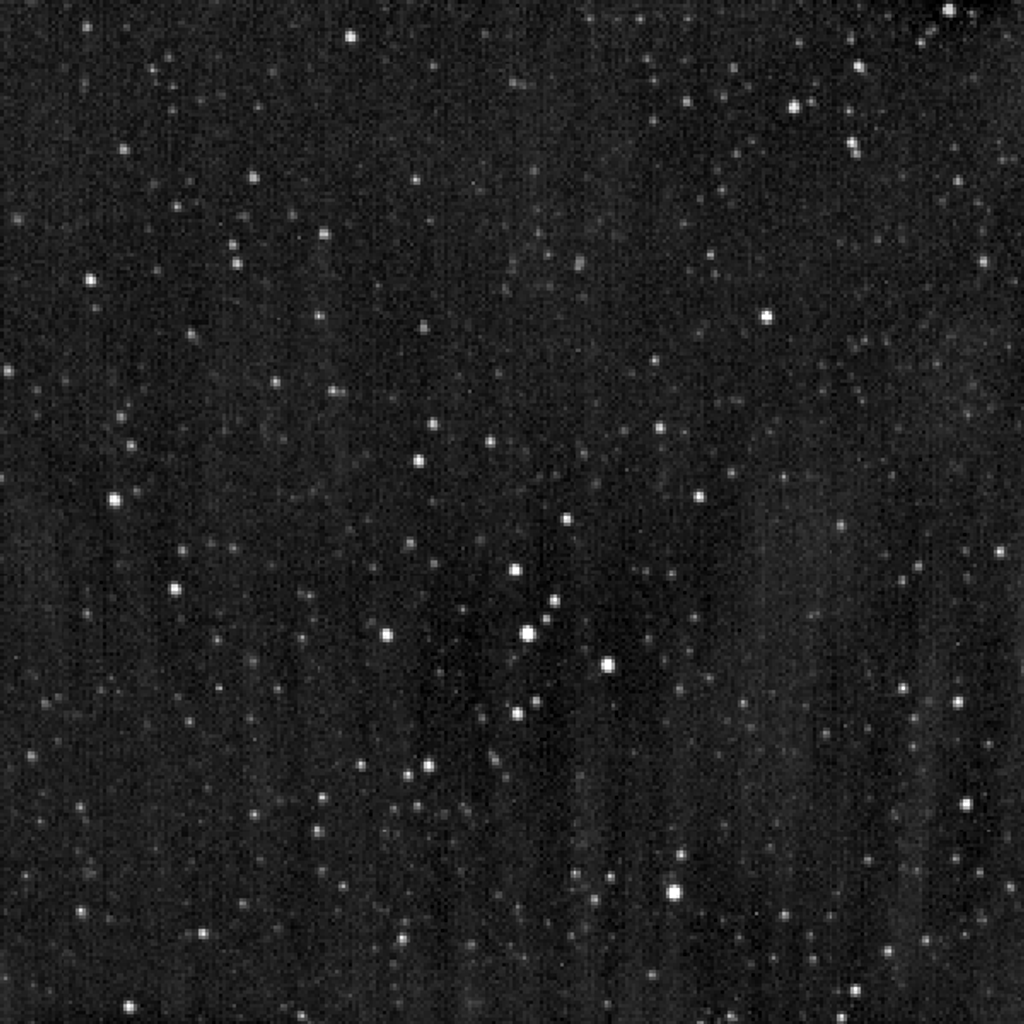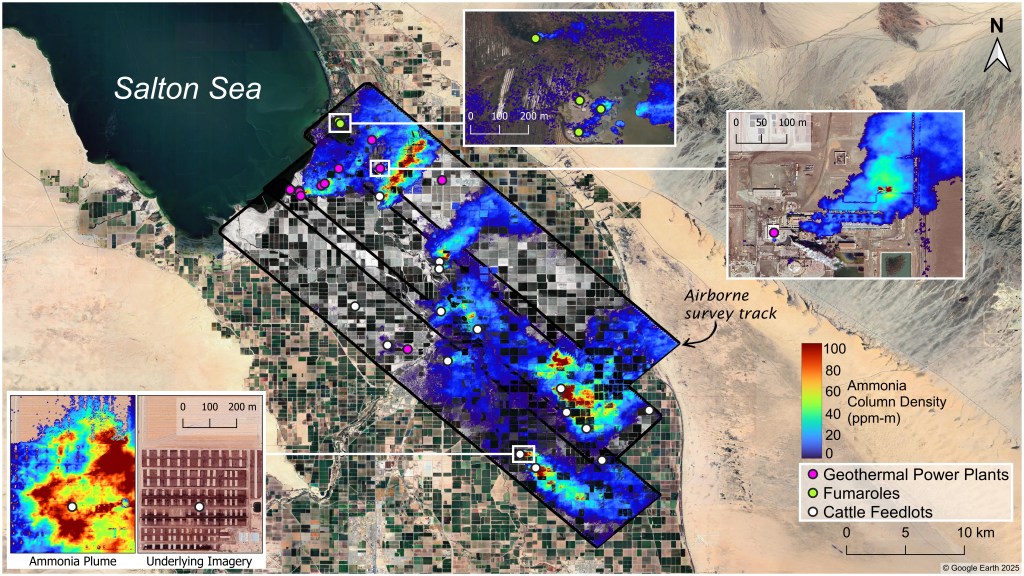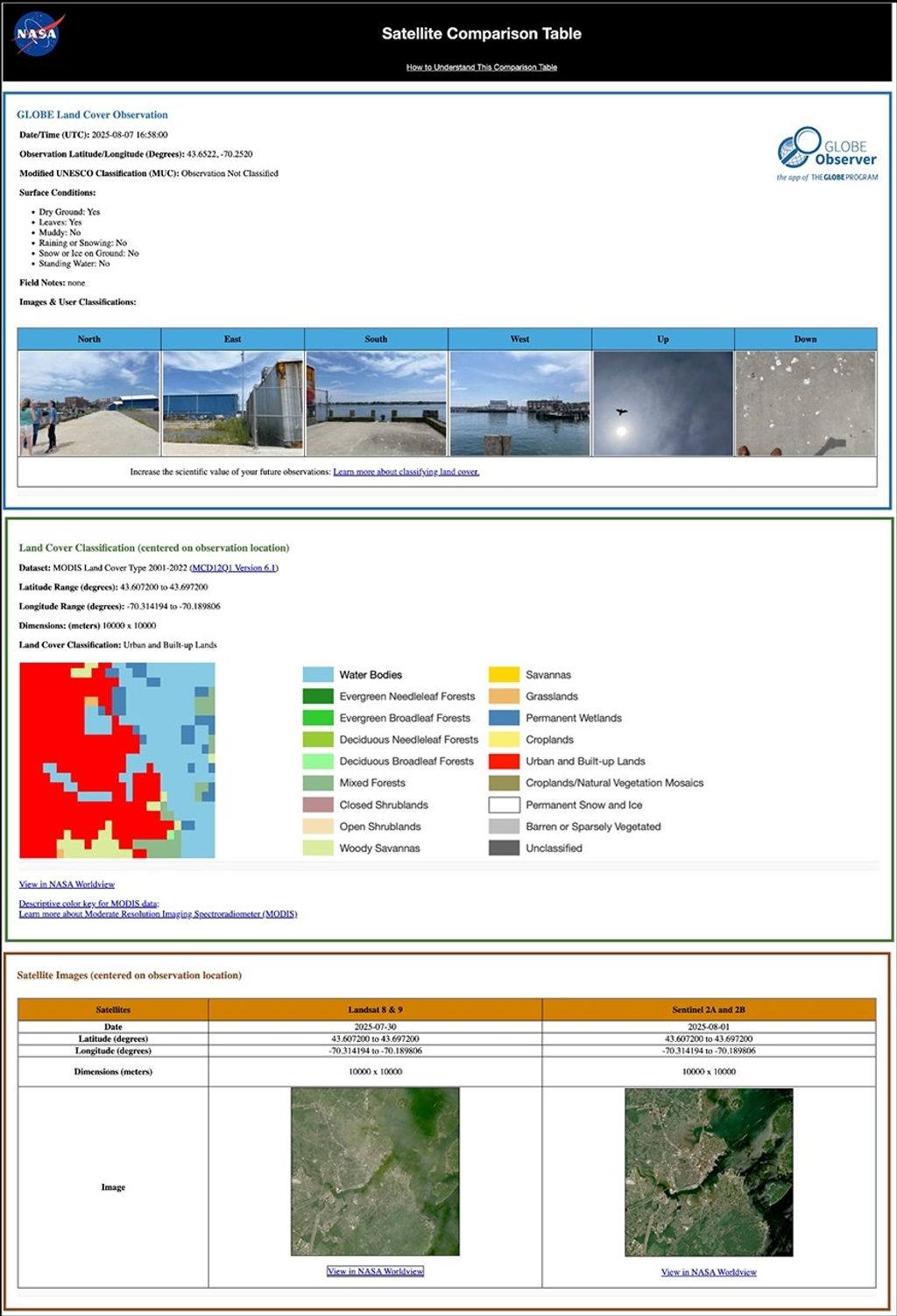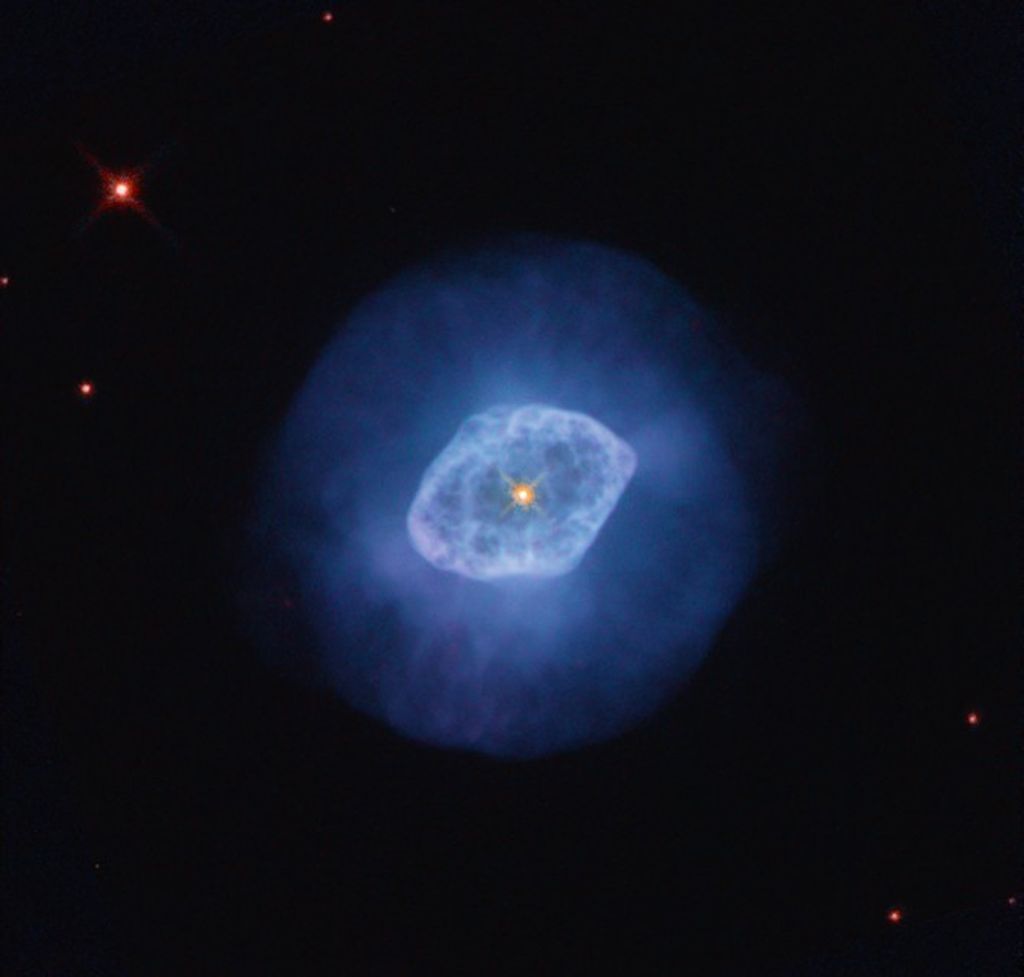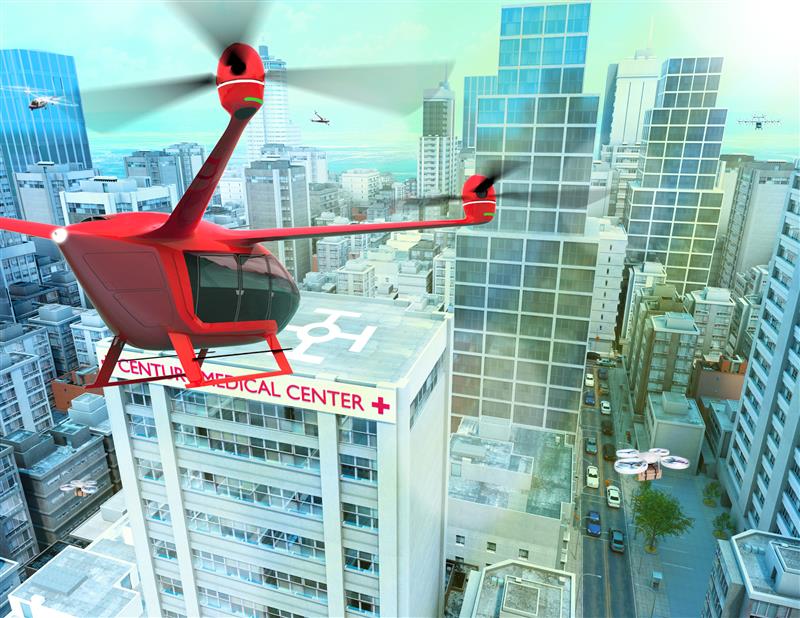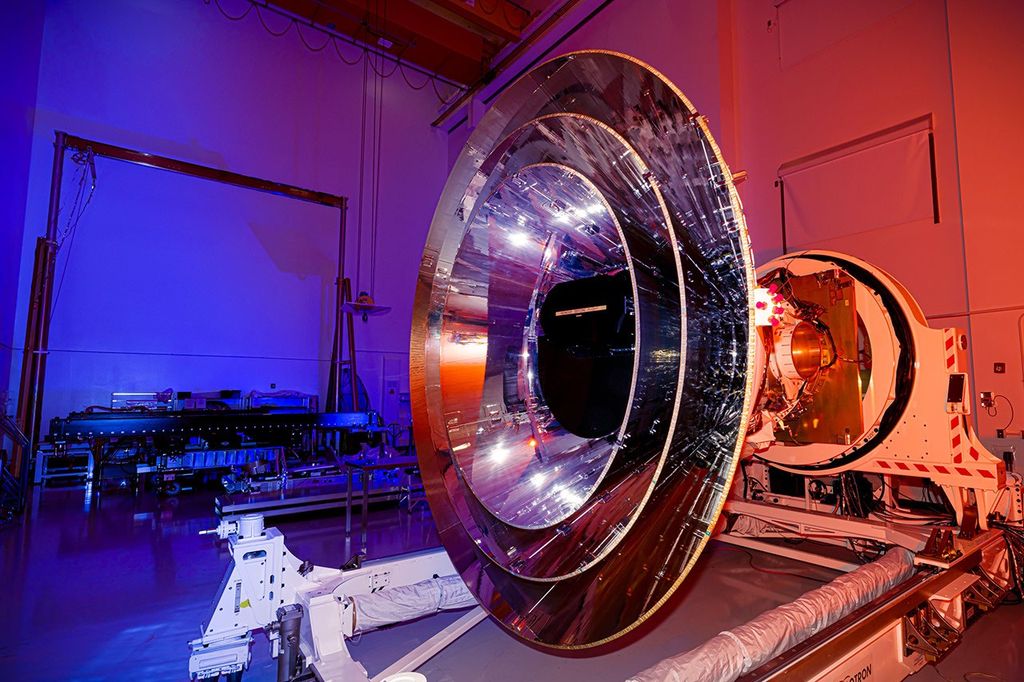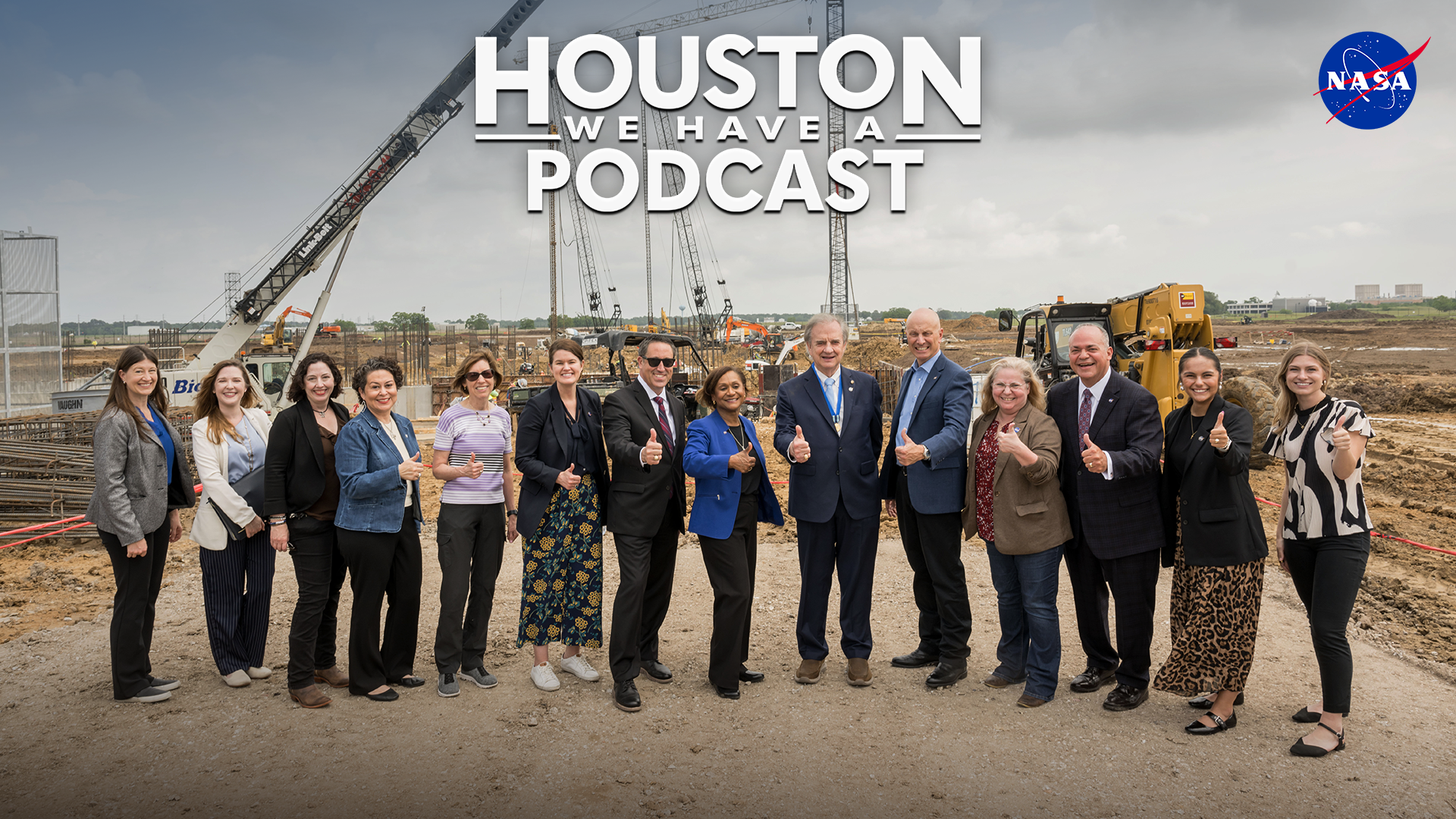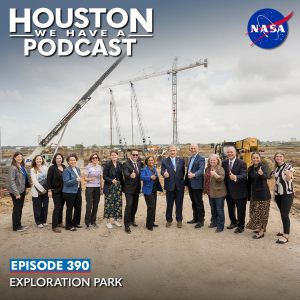
From Earth orbit to the Moon and Mars, explore the world of human spaceflight with NASA each week on the official podcast of the Johnson Space Center in Houston, Texas. Listen to in-depth conversations with the astronauts, scientists and engineers who make it possible.
On episode 390, two NASA experts talk about Exploration Park, a research facility near Johnson Space Center will enable collaboration with the agency on space hardware development. This episode was recorded April 24, 2025.
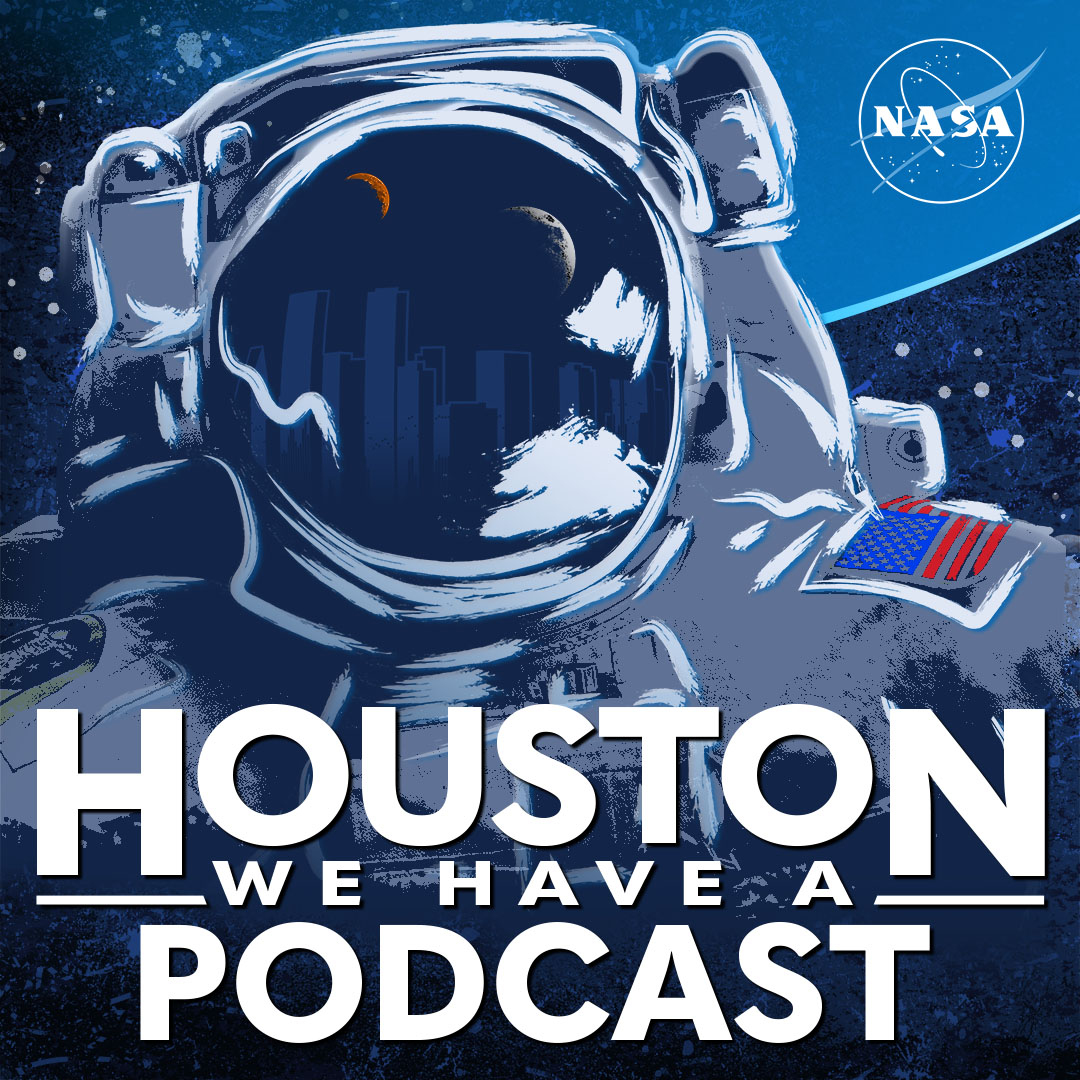
Transcript
Kenna Pell (Host)
Houston, we have a podcast! Welcome to the official podcast of the NASA Johnson Space Center, episode 390, Exploration Park. I’m Kenna Pell and I’ll be your host today. On this episode we bring in the experts, scientists, engineers and astronauts, all to let you know what’s going on in the world of human spaceflight and more. Just outside the gates of NASA’s Johnson Space Center here in Houston, ground has been broken on Exploration Park. The planned 240 acre research park will evolve with many academic, industrial, and international partner research facilities developed over multiple decades. The research park will create an infrastructure that allows for a multiuse space hardware development environment where academic researchers, aerospace companies, and entrepreneurs can collaborate with NASA. On today’s episode we talked to Johnson Space Center’s associate center director Donna Shafer, and Robert Durkin from the Extravehicular Activity and Human Surface Mobility Program. We’ll learn about Exploration Park and how it’ll play a key role in helping both Johnson and NASA reach their commercialization of space goals as well as work development US Space economy. Let’s dive in.
<Intro Music>
Kenna Pell
Donna, Robert, thank you so much for joining us on Houston We have a podcast today. We’re going to talk all things Exploration Park, but first, I think our listeners would love to get to know where you started and how you found your path to NASA. So first, Donna, tell us about your current role, and then can you talk about your path.
Donna Shafer
So I started here in, a long, long time ago, 35 years ago, as a temporary job while I went to law school at night. So I did information security, the secrets that protected the secrets cryptography, and so went to law school and never ended up leaving. I spent 22 years in the legal office, eventually becoming Chief Counsel before I moved into this job six years ago.
Kenna Pell
cryptography. You were doing that here. Uh huh, okay, and then I didn’t realize your legal background. Where did you go to law school?
Donna Shafer
I went to U of H at night. So, night school, okay?
Kenna Pell
And then where did you go for undergrad?
Donna Shafer
I went to a very small school in the north part of Texas called NMU, or Midwestern, right? So it looks and sounds like it is somewhere other than in the north part of Texas. Okay, so, yeah, it’s very, very small school criminal justice degree, looking to be a lawyer, obviously, back then, pre law club president and all that.
Kenna Pell
How do you feel like your background in law and your current job. How that’s helped?
Donna Shafer
So pretty much everything I’ve done has helped me get to where I am and helps me do my job today. So working shuttle back in the day to working in the legal office for a long time, doing a number of different jobs. but all of it helps me be better at my job today.
Kenna Pell
Got it, and I did not plainly ask, what is your role today?
Donna Shafer
Sorry, I am the Associate Center Director here at JSC, so I work for 11,000 people, and the way I describe my job is simplistically, it is my job to make sure everybody here has what they need to do their job.
Kenna Pell
. I love that. Okay, so our center director oversees this, and our deputy oversees this. And what do you oversee the people,
Donna Shafer
mostly the business and the people?
Kenna Pell
Okay, yeah, cool, yeah. And Robert, what about you? Tell us I’m gonna do this the right way. Tell us about your role now and then your path to getting there,
Robert Durkin
sure. So I’m in the EVA human surface mobility program, and I’m the facilities lead, so everything that we need to test and train for our crews and and all the support that needs to make it happen, responsible for making sure the the infrastructure is there and ready in time for us. How I got there, I started here at JSC in the early 90s through the Cooperative Education Program. I was a co op, and started out at the what if WETF weightless environment training facility, and worked my way up there, then transitioned over to the Neutral Buoyancy Lab and spent most of my years there, ended up as the chief from 2010 to 2016-2017, somewhere in there, and then worked in other areas, within FOD and in human in the loop testing. So anytime you had a crew member or any subject in a hazardous environment, that’s where I was usually where I ended up. So, in the last few years, we’ve been looking at what overall capabilities do, do we need? And actually did a rotation in the business development office looking at, at at those improvements, and one of those was Exploration Park, and there were others, but that was one of the main ones there that actually blossomed into what it is today.
Kenna Pell
What did you study?
Robert Durkin
So I’m an aerospace engineer. So from the Midwest, I went to Wichita State University. Lot
of shockers here in this area, or at least here at JSC. So Wichita was big in aeronautics, so you had all the big companies, Boeing Beach, Cessna, Learjet, all those there. They pumped a lot of money into the school. Had a lot of wind tunnels, a lot of testing capability there. So it was a great place to get an aero program. I actually started off as an aeronautical engineer, and then switched to aerospace, which then eventually got me, got me down here,
Kenna Pell
awesome. you mentioned facilities, and then you did mention NBL so facilities to practice space walks and stuff like that. Is that what you do?
Robert Durkin
So it, it’s kind of the the whole testing and training cycle. So we look at what kind of hardware do we need, and so anything from tools like, if you’re doing a space walk, what, what do you need when you go, when you go out, like on station, you know, you need a, you know, all the different tools to make you successful, like wrenches and power tools and stuff like that. So we look and make sure we have the facilities that can contest those and get them in the best possible environment. So one of the things that we’re looking for is is to provide a capability that the crew can have that mimics wherever we’re going to be taking them. For instance, like at the Neutral Buoyancy Lab, they use the buoyant properties of water to to weigh them out in in the NBL to simulate that as best we can. And so that’s one example. Then other areas or facilities are, like the pressure chambers we have, yeah. So you want to be able to put the crew in the in the same suit, in the same environment, so same temperature, same pressures that they’re going to see, and see how the suits going to act, how the gloves act, how, how the overall equipment works. You know, you want to, you want to find out any problems here before you’re you’re up on orbit, got it?
Kenna Pell
Okay, Donna, I think you naturally you did this already. Robert, can you explain your job in non space enthusiast talk?
Robert Durkin
My wife’s asked me this questions. Question multiple times. When I used to work at the NBL, it was easy. I just worked at a big swimming pool, so that was easy, but so it is, you know, having the right facilities capabilities, you know what we need to be able to test and train or cruise to be ready. So a lot of people think more of the building side of it, like an NBL. Or the chambers, or, yeah, or, you know, we’re looking at a larger rock yard and other capabilities, stuff like that. But there are other things too, that that we look at, like virtual reality and other type of immersive simulations or capabilities that that can can train our crews to be as ready as possible.
Kenna Pell
Got it okay? Well, at the time of this recording, there is a spacewalk coming up on May 1. Right. Did you support any of the training with that?
Robert Durkin
We do so EHP is responsible for not only exploration, so EVA Dev is building the new suits that we’re going to have. That axiom is building, but then also it takes care of what you usually call the legacy or the station hardware. So yes, so EHP does also have have that area as well, and I personally wasn’t involved, but our facilities were a lot of time was spent in the NBL and our other capabilities to get them ready.
Kenna Pell
Got it. Okay, well thank you for explaining your jobs. We’re here today to talk about Exploration Park. First and foremost. Can you explain what is Exploration Park?
Donna Shafer
So I will say at a high level, and then we can flip over to Robert to tell us the full kind of stuff that happens there, but it really is trying to find a location that is close to Johnson Space Center that is under utilized property. So it’s our property, but we don’t use it. So finding a way to look at how we do what we do in a different manner, to make the most of those facilities capabilities, to bring in academia, to bring in commercial world, to bring in entrepreneurs, to get together for that collaboration. And how do we together attack those greatest problems that we all need to solve to go further into the universe.
Kenna Pell
That was a perfect all encompassing, like elevator pitch, because it hit kind of all the questions. I want to dive deeper into perfect. So I’m just going to go down the list, because that was really great. First, how did the vision for this space come to life?
Donna Shafer
Yeah, and I will have to give all due credit to having a leadership team here at the Johnson Space Center that is strategic in nature, that looks beyond what we’re doing operationally, because we are an operational center, right? So looking out to the future, what do we need and how do we take care of ourselves in a better manner? Because we are all in a constrained resources environment. So less money, less resources, less capability, less people, but the demands of what we do to explore further, to go farther out into the universe, to find answers to those questions that’s over here, and we have to keep an eye on everything out there so that we can be good for the operations and what the agency needs. And so I give tremendous credit to our leadership team for putting together a very, very small, very exclusive team, because you can’t build anything like this with a large committee of people that came up with Dare To Explore as a thing for Johnson Space Center, a kind of anchor tenant that empowers all of us and engages all of us and gives us that authority to help decide, how do we do things better, to go further. So that team looking at, how do we do that? How do we engage the workforce? How do we ensure that the workforce understands that we actively depend on the entire team to do what we do, and so for our leadership team to understand how to engage all of us, all 11,000 of us here to say, Hey, I know how to do that better, or, Hey, this would be better over here. So Dare To Explore is really the foundation of all of that, and part of it is, how do we help ourselves? So we have an aging infrastructure. We were built in the 1960s and you can tell by walking around in our buildings and looking at our facilities that these are old facilities, and there’s not money coming in to help us restore those make those better for the workforce. So how do we do something that both enables us to be prepared for the future but also helps us on the facilities and infrastructure side as well, and this does both of those things. So just really, really amazed and always feel blessed to work for a leadership team that can look out that far in the future.
Kenna Pell
So many great. Quotes from that. One of them was doing things better to go further. Can you explain a little bit more what’s going to take place at Exploration Park?
Donna Shafer
Sure. So the park itself is like 240 acres. And we, we went out, and I have to also, please don’t let me forget to give huge kudos to NASA Headquarters, our Office of Strategic infrastructure, for having a process in place. So in June of 23 we put out an announcement it was out there for like a month, got proposals back in July, and then by the very next, February of 24 so last year we had proposals. We have two leases out there now. And if you could see Johnson Space Center today, you will see this huge construction zone on the 30 acres piece of what is Exploration Park. And I can go on and on about that. But I know my colleague can as well, Robert can tell you more, but, but having Texas A&M University systems, they have 30 acres. They are building a facility, and I’ll leave the details of what’s in the facility to you. So they’re building a facility. You can see that construction, they have, literally a construction cam that I’m super jealous that they have over there, where they can watch it daily from College Station. And so fun to watch, even from this vantage point of how we will forever change the way Johnson Space Center looks. And then right next to that we have a second lease, and that is to the American Center for manufacturing and innovation, or Acme, as we call them. And people of my age always looking for Wiley Coyote and the Road Runner when we say that. But that is a company based out of Austin. It was a development corporation, and they are leasing 50 acres. I love this term, because I’m a recovering attorney, more or less 54 acres. And so it’s a little bit less than 54 acres. And so they have that lease right next to where Texas A&M is building, and that will be available to our contract facility, any contractor, any commercial entity that is focused on what we do right so we ultimately, on the NASA side, have the ability to approve or disapprove folks coming in so that it doesn’t turn into, I don’t know what it could but, but like keeping it focused on what we do, right? And so Acme is developing the land just past where Texas A&M is building now, but this time next year, you will see a giant building there, and for all our Texas Aggies around that that building will be about the size of Kyle Field in College Station. So it is a huge facility.
Kenna Pell
You said keeping it focused on what we do here at Johnson Space Center. Can you talk about why proximity is so important?
Donna Shafer
Yes, and so a lot of that has to do with, you know, we have the crews here. We have the training here. We have, as we were talking about when, when I first started working here, the WETF, the weightless environment training facility, and I still remember that acronym from years and years ago. But so we have the infrastructure. We are the hub of human space flight, and we are looking to emphasize and retain that capability well into the future of the scope so we see Exploration Park is like another spoke in the hub, right? And so it’s helping us foster those relationships outside of what we do, but focused on what we do also. And so I think it’s important to note that basically all we’re doing there is bringing in new ideas and keeping everybody focused on us, helping the state of Texas and I am completely remiss in not saying the state of Texas stepping up and funding the facility that Texas A&M is building, huge investment in this region, in the state, in our nation, to have that facility built right next to us, which gives everybody their access to our team, our capabilities and what we do, so that collaboration is right next door the whole time.
Kenna Pell
Okay, and I am going to ask a little bit more about those partnerships in our next segment here, but first that you’ve already touched on this, the need to evolve. JSC has led human space flight for 60 years. And so how has the evolving space industry changed the way that we operate?
Donna Shafer
It’s been tremendous, the changes that I’ve seen in my career, right? So in 35 years, for 60 years, we’ve been the hub of human space flight, right? And so you go into that as competitors, where we are racing to space, we are racing to orbit, we are racing to everything against another nation. We’ve learned, and we all know this quote, right? If you want to go fast, go alone. If you want to go far, go together. And next thing we encounter is this idea of collaboration on an international level and bringing in partners and understanding that we’re all bringing unique aspects to everything we do, and so everything I think we do, and beyond there, where you see us now is more on the commercial front is, how do we enable commercial human space flight? How do we, how do we, NASA, get out of low Earth orbit entirely? Leave that to the commercial folks, and then go further on our own. And so it’s about kind of progressing what we do and how we do it based upon where we are, and that has drastically changed over the past 60 years,
Kenna Pell
and that ties it to the larger mission of NASA, right?
Donna Shafer
So I think all of it ties together in in the context of going further together, exploring further, and us being the hub of human space flight here at JSC. so, basically, that the bigger part of what the agency does is focused on human exploration here at JSC, and so we’re looking to invest on those collaborations and evolve so that we are doing more together with less resources.
Kenna Pell
Thank you. can you explain just the partnerships and how they were enabled and who helps enable them?
Donna Shafer
Yes, very excited to talk about the reason we have the Texas A&M Space Institute being built right next to the Johnson Space Center as our it’s actually technically on our land, and so we’re just pulling back the fence. And so that wouldn’t happen without the establishment of the Texas space Commission, which the governor came here. We’re so fortunate to have had him here last March to enable and announce the establishment of the Texas Space Commission, which not only funded the facility for the Space Institute, but also funds grants, which enables space exploration across the nation.
Kenna Pell
can you tell us a little bit more about the current partnerships.
Donna Shafer
Yeah, and so we’ve talked about Texas A&M University systems and the state coming in, but our other partner, Acme, they have built their business on working with the federal government, primarily with Department of Defense. They work with industry as well. So they are a commercial developer, but part of their primary focus has been with Department of Defense, and we’re looking forward to building our relationship, which we’ve always maintained, one, with Department of Defense here at NASA and certainly at JSC, but we’re looking to build it in new ways we hadn’t necessarily thought of through this collaboration.
Kenna Pell
over to you, Robert. where exactly is Exploration Park, and can the public go there?
Robert Durkin
So Donna did a great job in the overall vision, and I agree 100% on on us getting to this point.
but it’s kind of people might want to know where, where is this? So if you start over by the Saturn five building, and you can see the construction now, that’s where the Texas A&M facility. And we’re actually moving in the security gate. So eventually the gate will be where Saturn five is in that in that area, so the general public will be able to get into where Exploration Park is. And think of it kind of more as a business park, too, because there’s going to be different construction there. So A&M is the first company or first university to build there, but then there’ll be others. And Acme is, is a company that is good at building other structures, so they may build capabilities for other people to move into. So that’s kind of the overall vision of what they have. So just, just trying to catch up to
Kenna Pell
no, that’s perfect. I did have a question on what you mentioned about the general public, and you mentioned a security gate. Is that going to be on the that’s on the outside of Johnson Space Center,
Robert Durkin
so the Exploration Park will be outside the gate? Yeah, exactly.
Kenna Pell
Okay. And if you’re familiar with the space, it doesn’t it, it’s right next to the Longhorn project, right? Yep, right over there. Okay, can you tell us more about who the key players and partners are involved in Exploration Park?
Robert Durkin
Sure, like Donna had mentioned about, you know, we need to go as a team, as a group, you know, being able to pull on other, you know, academia, on other vendors, other contractors, and then eventually, as we partner with other international partners, all those can combine and come over here and work in Exploration Park. And our legacy capabilities are here on this side of the fence, but they are close, and we’ll be able to do a lot more partnerships and really work together. And you know, the funds that the state has put together is really going to help Springboard us. It brings capabilities together. And you know, we learn over the years. You put a lot of smart people in the same room or in close proximity, you come up with some amazing things. So really looking to get the synergy around this area. We are the hub of human space flight. So really leverage that and use the great brain trust we already have here. Combine it with others as they come in through Exploration Park, and really take this to a whole other level.
Kenna Pell
I like what you said on this side of the fence, the legacy knowledge and working with commercial partners to help us both go further. Can you talk a little more about leveraging commercial collaboration and how that benefits us here at NASA?
Robert Durkin
Yeah. So you know, we have a limited budget on what we can on what we’re provided through the federal government, and what we can do here. So by partnering with others, by using, you know, using the capabilities we have to push things further, but build that commercial space where, then they can start doing other things, a lot like what SpaceX has been doing now, where, you know, we first asked them to come on to to provide commercial cargo. Then they actually started bringing commercial crew, and then they’ve gone out on their own and are doing these other like Polaris Dawn and other commercial activities that they have. So that’s kind of what we want to do, is we can help with the hard what has been hard in the past. Help grow that. And then as it becomes more viable in the commercial space, then they can, can work with it, and then NASA can, can use its resources and energy on that cutting edge where a lot of the commercial people just can’t go
Kenna Pell
and with that. So you anticipate the surface mobility program being a user of this park. Can you explain your role in what you do now and how you’re helping commercial over an Exploration Park?
Robert Durkin
So my overall role within EHP is, is, again, to make sure we have the facilities and capabilities ready when we need them. One of the areas that is growing is obviously within Exploration Park with this Texas A&M Space Institute, and that is an area where we could, in the future, have a capability over there to be able to test and train our crews. The Space Institute itself is actually two landscapes, two and a half acre landscapes. One is lunar, one is Martian. And down the middle of that is what they call a garage area. There’s multiple garages pulled together, which gives people the or companies the ability to go and pull in hardware, prep it, get it ready for a test, and then go out and actually test whatever you know, whether it’s hardware or procedures or whatever they’re planning to do they’re planning to have the ability to change the landscape to however they need it. So they’ll have an electric bulldozer and other moving equipment and be able to get it in the right configuration that we need.
Kenna Pell
That is so cool. And so your Eva, do we have other programs across Johnson that have that are similar to you, in support, like, maybe, I don’t know, ISS or commercial or orbit development program, stuff like that?
Robert Durkin
So each one of those programs has their own group that deals with overall facilities and capabilities. So yes, so I have equal partners across other programs that do a very similar job, and we work together, because a lot of those programs, like the ISS, they we use a lot of the same capabilities and facilities. So we work together. We do a cost sharing when it makes sense, and be able to keep these capabilities at the appropriate level for what we see. So yeah, we definitely work with the other programs. Got it okay, and there was a recent groundbreaking right? Can you talk about what stage of development all of Exploration Park is in now and then a little bit on our organizations building their own facilities, or are there already going to be facilities built that organizations can go into? So right now, the A&M has already broke ground, they’ve gone through the critical design review, and they’re in the process now of building the facility that that they eventually will have, so the Texas A&M is allowing different organizations, different companies, to come in and rent space within their facility. So there will be potential for people to come in and other companies to use that space. Now, Acme is a developer, so they most likely would be developing facilities that people could use. And I don’t know if the how far the decision has gotten in that area, but that was the overall concept of the developers coming in would provide that so in in the future, we would have these capabilities in these buildings, in this Exploration Park, this business park that we have next door to us.
Kenna Pell
I like that business park, there’s a whole bunch of cranes over there, which is a new thing as of recent And so you mentioned Texas A and M Space Institute has broken ground. What’s the status on their building? Or is that what those cranes are doing over there? Is that?
Robert Durkin
Exactly. So they’re setting up the base structure for for that facility, and they’re planning to have that completed in in the fourth quarter of FY26 so next year, around the September time frame is what, what they’re shooting for.
Kenna Pell
You both are involved in behind the scenes. Can you talk about some of the planning that’s gone into bringing Exploration Park to life.
Robert Durkin
So there was a great vision, initially of what we could do. There’s other examples out that out there, like Marshall and Kennedy Space Center. They, yeah, they, they have some great capabilities. So kind of using that as an initial idea, and then just taking a level of what we can do here. So it, it really is the initial building blocks of what could be amazing. The it’s going to change here quickly with the addition of the the Space Institute. But I think I’ve been here not quite as long as Donna, but quite a few years, and we’ve been kind of stagnant on when you look at JSC that we’ve had a few new buildings here and there, but nothing really revolutionary or changing or now the gate, the fence is changing. There’s going to be these significant buildings coming in, and these great partnerships that are really going to be amazing.
Kenna Pell
How would you describe, you said, business park. Could you describe this similarly to, like, a business incubator that maybe a university is helping with? Is that kind of similar
Robert Durkin
So we, you know, there’s a lot of different directions this could go. That’s definitely one where, you know, A&M obviously has at least here now, but you know, there could be other universities that are coming in. You know, depends on how Acme sets it up. They could have an incubator type style, where they they set up a workspace, where you could have it happen. It’s, I wouldn’t say it’s complete blank slate, but it’s pretty close at it right now, or there’s a lot of different directions that could go.
Kenna Pell
Let’s talk about the goals and the future of Exploration Park. First, Donna, with your role here at NASA Johnson primarily being focused on facilities, workforce, people. How do you expect Exploration Park to impact the workforce?
Donna Shafer
So, I think the impacts could be tremendous, right? And so what it does is take things we have done locally, and travel to whether it’s to a university to an innovation hub, to different partners, and brings it local so that we can have greater participation from the workforce and more of us working together with our partners in the future. So tremendous impact, and it also serves as a way of making sure, when we talk capabilities at JSC, making sure that we retain those capabilities locally. And that’s been a big kind of focus for all of us in making sure that as we evolve, that we retain the capabilities that we will need in the future.
Kenna Pell
Thanks for covering workforce. So how do you envision this space supporting next generation of aerospace professionals?
Donna Shafer
So I again, I think that’s big, right? Because you’re talking Texas A&M coming in here, potentially other universities coming in here, and so changing kind of the way we work together within the state of Texas and within the nation, and then externally, outside of this nation as well, and so bringing more of us together. And I think there’s like such tremendous potential there for creating a workforce that we don’t even necessarily understand we need in this moment. Sure.
Kenna Pell
How do you see it evolving in the next 10 years, 20 years? What do you expect? Or what do you hope to see?
Donna Shafer
Yeah, it’s interesting, because I have been here for a few decades, and so watching us evolve over time, and that’s the one constant that we’ve seen throughout the years is our mission changes. It’s sometimes a slight change and sometimes a drastic change. And so with each administration, our mission changes a little bit. And so we have to have that agility and that ability to pivot and focus on what we need to be doing for our Space Center here at JSC, for our state, for our nation, and really focusing on all of the tremendous benefits that we have for the whole world.
Kenna Pell
Good question to end o, how would you explain Exploration Park to someone who’s never heard of something like this before? This concept or…
Donna Shafer
I think I would explain it as well. I have to explain it in two different ways. One is as a federal employee when I want to explain it, and that is, it is daring to do things that I’ve never seen us do before, and that is look outside ourselves as the experts, are the exclusive experts in everything. And so as a federal employee, I am in awe of what this place is going to look like for your kids, for your grandkids, because it’s nothing is going to be the same. And I think it’s amazing to be part of that change in who we are, because it it demonstrates to all of us that we can change what we do. We can change the focus of what we do. We are still doing amazing, tremendously impressive, brilliant work in exploring beyond our own planet. But the idea that we can locally shift with all of that. Now, for someone who doesn’t know Exploration Park at all, it is the idea of building a community where we we have a place where experts from commercial, from, you know, industry, from academia, from entrepreneurs, bringing all of them together to solve our greatest problems and putting it in place where it’s next to the experts in human Space Flight, right? So they can work together, and so putting it right next to Johnson Space Center is just a way to actually accelerate in a way we hadn’t thought of that ability that NASA has to make life better for all humanity.
Kenna Pell
Donna Robert, thank you so much for joining us today. Thank you. Thanks.
<Outro Music>
Kenna Pell
Thanks for sticking around. I hope you learned something new today. You can check out the latest from around the agency at nasa.gov and can find out full collection of episodes and all of the other wonderful NASA Podcasts at nasa.gov/podcasts. On social media we are on the NASA Johnson Space Center pages of Facebook, X, and Instagram. If you have any questions for us or suggestions for future episodes, email us at NASA-Houstonpodcast@mail.nasa.gov.
This interview was recorded on April, 24th 2025.
Our producer is Dane Turner. Audio engineers are Will Flato and Daniel Tohill. And our social media is managed by Dominique Crespo. Houston We Have a Podcast was created and is supervised by Gary Jordan. Special thanks to Mia Garza and Paige Romanowski for helping us bring this episode to life. And of course, thanks again to Donna Shafer and Robert Durkin for taking the time to come on the show.
Give us a rating and feedback on whatever platform you’re listening to us on and tell us what you think of our podcast. We’ll be back next week.






